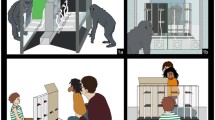Abstract
Animals react in many different ways to being watched by others. In the context of cooperation, many theories emphasize reputational effects: Individuals should cooperate more if other potential cooperators are watching. In the context of competition, individuals might want to show off their strength and prowess if other potential competitors are watching. In the current study, we observed chimpanzees and human children in three experimental conditions involving resource acquisition: Participants were either in the presence of a passive observer (observed condition), an active observer who engaged in the same task as the participant (competition condition), or in the presence of but not directly observed by a conspecific (mere presence condition). While both species worked to acquire more resources in the competition condition, children but not chimpanzees also worked to acquire more resources in the observer condition (compared to the mere presence condition). These results suggest evolutionary continuity with regard to competition-based observer effects, but an additional observer effect in young children, potentially arising from an evolutionary-based concern for cooperative reputation.


Similar content being viewed by others
References
Allport FH (1920) The influence of the group upon association and thought. J Exp Psychol 3:159–182
Banerjee R (2002) Children’s understanding of self-presentational behavior: links with mental-state reasoning and the attribution of embarrassment. Merrill Palmer Q 15:378–404
Barclay P (2013) Strategies for cooperation in biological markets, especially for humans. Evol Hum Behav 34(3):164–175
Bateson M, Nettle D, Roberts G (2006) Cues of being watched enhance cooperation in a real-world setting. Biol Lett 2(3):412–414. doi:10.1098/rsbl.2006.0509
Baumard N, Andre J-B, Sperber D (2013) A mutualistic approach to morality: the evolution of fairness by partner choice. Behav Brain Sci 36:59–122
Chen SC (1937) The leaders and followers among the ants in nest-building. Physiol Zool 10(4):437–455
Clayton DA (1978) Socially facilitated behavior. Q Rev Biol 53(4):373–392
Dashiell JF (1935) Experimental studies of the influence of social situations on the behavior of individual human adults. In: Murchison C (ed) A handbook of social psychology. Clark University Press, Worcester, pp 1097–1158
Engelmann JM, Herrmann E, Tomasello M (2012) Five-year olds, but not chimpanzees, attempt to manage their reputations. PLoS One. doi:10.1371/journal.pone.0048433
Engelmann JM, Over H, Herrmann E, Tomasello M (2013) Young children care more about their reputations with ingroup members and potential reciprocators. Dev Sci 16(6):952–958
Guerin B (1986) Mere presence effects in humans: a review. J Exp Soc Psychol 22(1):38–77
Haley KJ, Fessler DM (2005) Nobody’s watching? Subtle cues affect generosity in an anonymous economic game. Evol Hum Behav 26:245–256. doi:10.1016/j.evolhumbehav.2005.01.002
Hare B, Tomasello M (2004) Chimpanzees are more skilful in competitive than in cooperative cognitive tasks. Anim Behav 68(3):571–581. doi:10.1016/j.anbehav.2003.11.011
Leimgruber KL, Shaw A, Santos LR, Olson KR (2012) Young children are more generous when others are aware of their actions. PLoS One 7:e48292. doi:10.1371/journal.pone.0048292
Melis AP, Hare B, Tomasello M (2006) Chimpanzees recruit the best collaborators. Science 311:1297–1300
Milinski M, Semmann D, Krambeck H-J (2002) Reputation helps solve the ‘tragedy of the commons’. Nature 415:424–426. doi:10.1038/415424a
Muller MN, Mitani JC (2005) Conflict and cooperation in wild chimpanzees. In: Slater P, Snowdon C, Roper T, Brockmann HJ, Naguib M (eds) Advances in the study of behavior, vol 35. Academic Press, San Diego, pp 275–331
Nettle D, Cronin KA, Bateson M (2013a) Responses of chimpanzees to cues of conspecific observation. Anim Behav 86(3):595–602. doi:10.1016/j.anbehav.2013.06.015
Nettle D, Harper Z, Kidson A, Stone R, Penton-Voak IS, Bateson M (2013b) The watching eyes effect in the Dictator Game: it’s not how much you give, it’s being seen to give something. Evol Hum Behav 34:35–40
Nowak MA, Sigmund K (2005) Evolution of indirect reciprocity. Nature 437:1291–1298
Platt JJ, Yaksh T, Darby CL (1967) Social facilitation of eating behavior in armadillos. Psychol Rep 20(3):1136
Shaw A, Montinari N, Piovesan M, Olson KR, Gino F, Norton MI (2014) Children develop a veil of fairness. J Exp Psychol Gen 143:363–375
Sylwester K, Roberts G (2010) Cooperators benefit through reputation-based partner choice in economic games. Biol Lett 6(5):659–662
Tomasello M (2014) A natural history of human thinking. Harvard University Press, Cambridge
Zajonc RB (1965) Social Facilitation. Science 149(3681):269–274
Acknowledgments
We thank Martin Mulama, Richard Vigne, George Paul, the board members and all the staff of Sweetwaters Chimpanzee Sanctuary in Kenya. In addition, we thank Jana Jurkat and Katharina Haberl for their help in testing the children. Finally, thanks go to Marike Schreiber, Raik Pieszek and Colleen Stephens.
Funding
This research was supported by the Max Planck Society.
Author contribution
J.M.E., E.H., M.T. designed the study; J.M.E. & E.H. conducted the study; J.M.E., E.H., M.T. analyzed the data; J.M.E., E.H., M.T. wrote the manuscript.
Author information
Authors and Affiliations
Corresponding author
Ethics declarations
Conflict of interest
The authors declare no competing interests.
Rights and permissions
About this article
Cite this article
Engelmann, J.M., Herrmann, E. & Tomasello, M. The effects of being watched on resource acquisition in chimpanzees and human children. Anim Cogn 19, 147–151 (2016). https://doi.org/10.1007/s10071-015-0920-y
Received:
Revised:
Accepted:
Published:
Issue Date:
DOI: https://doi.org/10.1007/s10071-015-0920-y




